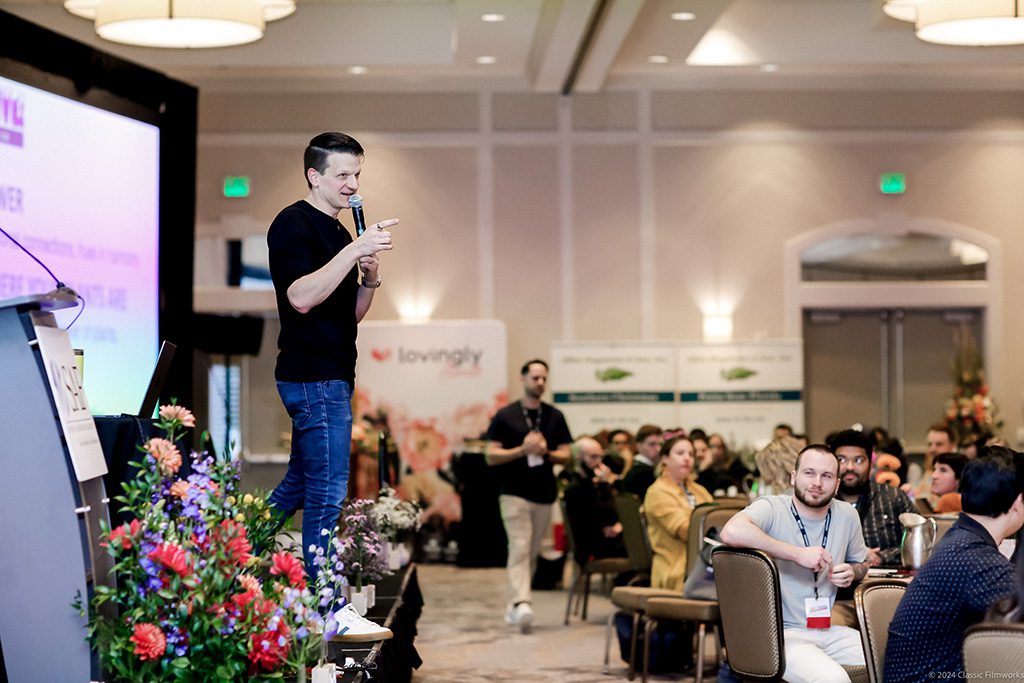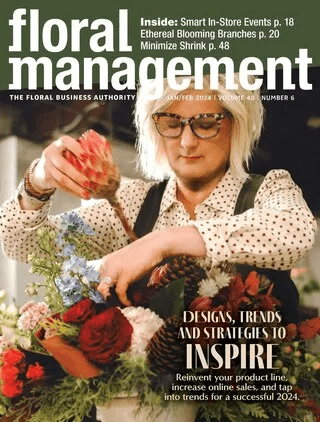
“Wholesalers are the best for sourcing the highest quality flowers and treating them properly to make sure they last,” said WF&FSA’s new president, Santiago Cock-Rada.
When it comes to getting a good value on top quality product delivered efficiently to retail flower shops, Santiago Cock-Rada is adamant: Wholesalers do it best.
The statement shouldn’t come as a surprise. After all, Cock-Rada, the general manager of Liberty Blooms, is president of the Wholesale Florist & Florist Supplier Association. In that role, Cock-Rada, the group’s first Colombian president, is charged with supporting and promoting wholesalers — but his passionate argument for the segment goes far beyond talking points and stump speeches. When growers and retailers work alongside wholesalers, he says, the industry, and ultimately consumers, benefit.
“We as an industry, have much to gain by allowing the importers and wholesalers to do their job of pooling large volumes to expedite and simplify the flow of products through the industry’s logistical bottleneck as opposed to the retailers painstakingly taking the time to perform small scale procurement functions on their own,” he said. “The greater efficiencies that we can achieve will not only translate into meaningful lower costs but, more importantly, our flowers will last longer.”
During a visit to the Society of American Florists’ headquarters late last year and in subsequent interviews with E-Brief editors, Cock-Rada talked more about consumer segments that deserve more attention from retailers, how technology and big data could transform wholesale operations, and what he sees as the hidden costs to florists, growers and consumers of direct buying.
You’ve summarized a recent Prince & Prince survey as a “comeback of the wholesalers as a prominent player in all segments of the floral industry.” That report comes amidst other predictions, including those of Society of American Florists CEO Peter Moran, that the wholesale industry will continue to shrink (from 550 to 570 wholesale doors today to only about 300 by 2020, according to Moran’s estimate). Can you talk more about the opportunities and changes you see? Profiling U.S. Wholesale Florist Operational Practices & Financial Performance.pdf
Santiago Cock-Rada: The current landscape has ripe opportunities for wholesalers in each and every consumer segment depending on their core competencies and strategic advantages. Indeed, the Prince & Prince results show that many wholesalers are very actively going after these opportunities.
Wholesalers are the best at sourcing the highest quality flowers and treating them properly to make sure they last. I believe wholesalers are ahead of the curve in our industry in terms of care and handling practices as well as cool chain management. In WF&FSA we acknowledge the importance of this aspect in our members’ operations and we will be on the lookout for ways to help them fill the gaps that still exist and capture the opportunities that may arise in this sense.
EB: What are those segments that are ripe for growth, and how do they relate to the core competencies?
SCR: The first is “high end deco,” which includes artwork, events and fancy interior decoration. The product presentation here is basically non-assembled, in bulk or “raw” product.
This segment drives the highest prices, demands the best quality, but has the lowest flower consumption per capita potential. We believe the “traditional” distribution channel is better able to service this consumer segment and has capitalized most of this segment’s potential (i.e., it is close to saturation). The main challenge here is to find innovative and exclusive ways to increase the consumption potential of this segment and move its saturation point to a higher level.
The second is “gift giving,” when somebody gives flowers to a relative or friend and triggers all those incredible sensations described in the research funded by the Society of American Florists. This segment has a much higher consumption per capita potential than the previous segment but can only be capitalized if a price-point “sweet-spot” is achieved. The masters at figuring out price-point sweet-spots and luring crowds to the floral category are those players in the mass market distribution channel. The presentation of the product for this segment is as bouquets and arrangements rather than raw and the main challenge has been quality and longevity — to have the bouquets and arrangements make the gift-giver look good, instead of not so good (not to say awful) because the flowers don’t last. Forward-thinking mass marketers are finding, however, that they need to not only team up with trendy retail florists to have their floral category perform up to their expectations (but also) involve the wholesaler in the sourcing of the fresh flowers to guarantee product that has been well cared for.
Finally, “self-consumption” has the most per capita consumption potential if we can successfully awaken it like Europe has been able to.
EB: How do we do that?
SCR: To awaken this “sleeping giant,” we need the lowest price point; which in turn can come with the scale it reaches if awakened. This, of course, is the classic problem of which comes first: the chicken or the egg? However, above all, we need to solve the problem of this segment currently receiving the product with the worst performance and bring down the sophism that fast delivery makes up for improper cold chain during delivery. Wholesalers are all about scale and proper cold chain management. Together with the retail florists they can offer the capillarity in distribution that this segment must have to succeed.
EB: Some retailers see significant cost savings when they buy direct. That’s hard to ignore. What would you say to them?
SCR: Due to the perishable nature of our product and because transportation (both air and ground) is such a considerable component of the cost of our product at retail, the dubious individual savings of buying apparently cheaper product in small volumes at farm-gate come at the huge expense of crippling the logistics chain for everyone’s product going through Miami.
EB: How does a retailer buying direct slow down the entire distribution chain?
SCR: Flower from South America must be inspected and cleared by PPQ (Plant Protection & Quarantine) in Miami. Every time a plane with flowers lands, the airline assigns PPQ a place in line to inspect and clear the plane’s load. Any delay in the inspection and clearance of one plane results in a delay for all planes in line (much like a toll booth effect). The amount of paperwork and product that this team goes through skyrockets when retailers move to buy small quantities of each different type of flower from many different farms at farm-gate. This generates way more physical inspection of flowers, so there is much more product being roughly treated and put on hold due to interceptions of pests or diseases.
These interceptions also require a cumbersome process of determining if any expensive fumigation or destruction action should be performed. The waiting time has gotten to be so long that the airlines have had to invest heavily in huge cooler space to keep a rising number of plane loads of flowers stored under proper temperatures while they wait for their turn to be processed by CBP inspectors. The airlines [must] severely delay their flights, and thus their profitability, to avoid being forced to unload planes in non-cooled facilities.
So, it is no wonder that groups like the Association of Floral Importers of Florida have reported an alarming surge in product interceptions, a sharp increase in freight surcharges for everyone and a huge backlog of poorly cooled product frequently seen at all airports of origin. These very harmful unintended consequences of buying direct affect us all.
EB: What do you think wholesalers, on the whole, need to do a better job of doing?
SCR: I see wholesalers starting to realize the importance of implementing new technologies and software to run their operation based on Business Intelligence (BI) tools and moving away from making decisions based on scarce data and just “experience,” pure instinct or hunches.
For wholesalers to add value to the retailers they need to take a strong stock position both on hard goods and fresh flowers. Nonetheless, we have wholesalers that are gravitating to the “drop ship model” where they significantly limit what they stock and just act as an order taker who holds the receivables, are limiting the value they can provide the retailer and thus limiting their revenue potential.
BI gives wholesalers the capability to do a much better job of understanding their local market and stocking accordingly. For starters, BI can reveal customer segments like urban vs. rural or basics vs. novelties to name just a couple. By using BI tools, wholesalers can drill down into what is and isn’t working in particular markets, even if they have locations in many diverse markets, to best capitalize on sales. The name of the game is, “Right product. Right place. Right time.” The ticket to be in the game is BI.
EB: Some retailers say they can’t count on their wholesalers to have some of the more unusual product and varieties, products that are key to helping them stand out from mass market and drop ship competitors. When they ask for these products, wholesalers say they can’t afford to add it to their inventory mix. What’s your response?
SCR: Communication and trust between the retailer and wholesaler is key. Wholesalers sometimes are wary of the unusual products as demand is tough to predict and driven by the limited end consumer appeal due to the consumer’s lack of knowledge of the unusual product. Unusual products tend to be more expensive versus other product choices. It also may be that the unusual product has a limited perishable life and depending on shipping distances that limited life may be further reduced.
If the retailer can provide the wholesaler an idea of the commitment they can make on a weekly basis it helps the wholesaler determine if it’sprofitable to offer the product. If a wholesaler buys a box of 20 bunches of flowers and sells them at a 35 percent wholesale gross margin, the wholesaler needs to sell 13 bunches to just cover its product cost. You sell less than 13 bunches you lose money. If you sell more than 13 bunches you have a contribution toward your costs for the purchasing staff that spent time sourcing the product, the staff that received and processed the product and the staff that sold the product.
Besides making decisions on the inclusion of unusual products in everyday inventory mix, wholesalers also work every day with their regular customers on special orders for unusual items. Sourcing from a broad base of established vendors and utilizing existing logistic cold chain channels, wholesalers are able to expeditiously deliver those special orders for their customers. When there is trust and strong communication in the relationship between the retailer and wholesaler unusual products and varieties are not out of reach for the retailer.
WF&FSA had record-breaking attendance at its annual conference last fall. What are you doing to build the organization now?
One key strategy to reach record-breaking attendance is to purposefully tailor education that is focused and relevant to the wholesale industry. Both young and seasoned members get an opportunity to hear professional speakers and then discuss amongst their peers how the particular topic applies within the wholesale industry.
With respect to building our organization, we believe that small wholesalers have the most to benefit from coming together under WF&FSA. They are poised to get the most out of the networking opportunities we offer. Additionally, WF&FSA can serve as a vehicle to attain the critical mass they can’t on their own to access affordable high level education or group discounts in common services they use.
Besides, the Prince & Prince study as well as other surveys we have conducted internally in WF&FSA show that there is an interesting number of one-store wholesalers out there that still don’t belong to WF&FSA and we want to attract them.
Regarding bringing the younger members of our industry to be actively involved in WF&FSA, this is a no-brainer. Just by seeing the trends in the demographics relevant to our industry in SAF’s 2016 Generations of Flowers Study we see the urgent need to get the younger generation to help us keep up with change and make our association vibrant and relevant.










